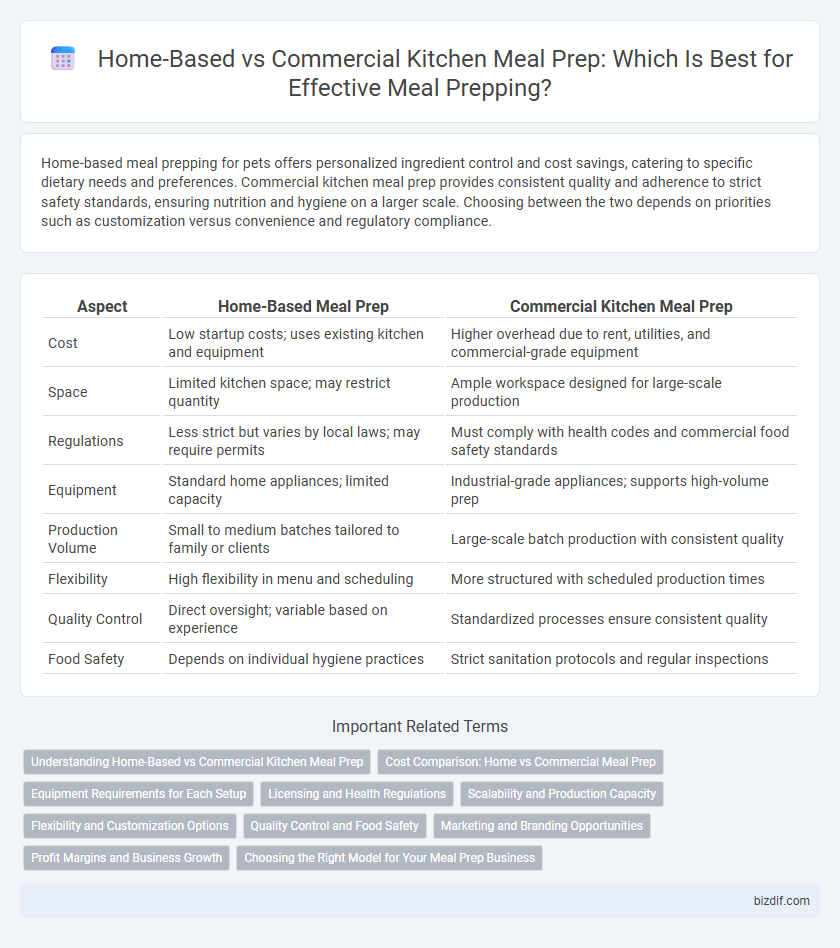Home-based meal prepping for pets offers personalized ingredient control and cost savings, catering to specific dietary needs and preferences. Commercial kitchen meal prep provides consistent quality and adherence to strict safety standards, ensuring nutrition and hygiene on a larger scale. Choosing between the two depends on priorities such as customization versus convenience and regulatory compliance.
Table of Comparison
| Aspect | Home-Based Meal Prep | Commercial Kitchen Meal Prep |
|---|---|---|
| Cost | Low startup costs; uses existing kitchen and equipment | Higher overhead due to rent, utilities, and commercial-grade equipment |
| Space | Limited kitchen space; may restrict quantity | Ample workspace designed for large-scale production |
| Regulations | Less strict but varies by local laws; may require permits | Must comply with health codes and commercial food safety standards |
| Equipment | Standard home appliances; limited capacity | Industrial-grade appliances; supports high-volume prep |
| Production Volume | Small to medium batches tailored to family or clients | Large-scale batch production with consistent quality |
| Flexibility | High flexibility in menu and scheduling | More structured with scheduled production times |
| Quality Control | Direct oversight; variable based on experience | Standardized processes ensure consistent quality |
| Food Safety | Depends on individual hygiene practices | Strict sanitation protocols and regular inspections |
Understanding Home-Based vs Commercial Kitchen Meal Prep
Home-based meal prep offers personalized control over ingredients and portion sizes, ideal for small-scale or dietary-specific needs, while commercial kitchen meal prep provides higher volume production with standardized processes ensuring food safety and consistency. Commercial kitchens must comply with health regulations and utilize industrial-grade equipment, making them suitable for large orders and business operations. Understanding these differences helps individuals and businesses choose the appropriate prep environment based on scale, regulatory requirements, and food quality priorities.
Cost Comparison: Home vs Commercial Meal Prep
Home-based meal prepping significantly lowers costs by eliminating rental fees and reducing utility expenses, making it an economical choice for individuals. Commercial kitchen meal prep incurs higher overhead due to space rental, equipment maintenance, and compliance with health regulations. Budget-conscious meal planners often prefer home-based setups to maximize savings while maintaining control over ingredient quality.
Equipment Requirements for Each Setup
Home-based meal prep typically requires basic kitchen equipment such as slow cookers, food processors, and standard baking sheets, while commercial kitchens demand high-capacity ovens, industrial mixers, and large-scale refrigeration units to handle bulk food production efficiently. Commercial setups prioritize equipment that meets health and safety regulations, including stainless steel surfaces and commercial-grade ventilation systems, whereas home kitchens focus on versatility and space-saving appliances. Investing in specialized commercial kitchen tools enhances productivity and ensures compliance, contrasting with the more flexible and cost-effective equipment array found in home-based meal prep environments.
Licensing and Health Regulations
Home-based meal prep often requires fewer licensing hurdles but must still comply with local health codes, which vary significantly by region. Commercial kitchens are subject to stricter health regulations, including mandatory inspections and certifications, ensuring higher standards of food safety and sanitation. Choosing between home-based and commercial kitchen meal prep depends on the scale of operation and adherence to regulatory compliance to avoid legal issues.
Scalability and Production Capacity
Home-based meal prep offers limited scalability due to space and equipment constraints, making it ideal for small batches or personalized orders. Commercial kitchen meal prep supports high production capacity and streamlined workflows, enabling the handling of large volume orders efficiently. Businesses aiming for rapid growth or bulk supply should prioritize commercial kitchens for consistent output and scalability.
Flexibility and Customization Options
Home-based meal prep offers greater flexibility in scheduling and ingredient selection, allowing individuals to tailor meals to personal dietary preferences and portion sizes. Commercial kitchen meal prep typically operates under standardized processes, limiting customization but ensuring consistency and efficiency for larger batch cooking. Choosing between the two depends on the balance between personalized meal options and volume-oriented production needs.
Quality Control and Food Safety
Home-based meal prep offers personalized quality control with direct oversight of ingredient selection and preparation methods, minimizing contamination risks through stringent hygiene practices. Commercial kitchen meal prep adheres to standardized food safety regulations enforced by health authorities, ensuring consistent sanitation protocols and temperature control across large-scale production. Both environments prioritize quality and safety, but commercial kitchens benefit from professional-grade equipment and formal certification processes that support higher volume consistency.
Marketing and Branding Opportunities
Home-based meal prep offers personalized branding opportunities through direct customer engagement and customizable packaging, enhancing brand loyalty. Commercial kitchen meal prep enables scaling marketing efforts with consistent product quality and broader distribution channels, increasing brand visibility. Leveraging digital platforms amplifies both models by showcasing unique selling points and maximizing reach to target audiences.
Profit Margins and Business Growth
Home-based meal prep businesses typically benefit from lower overhead costs, resulting in higher profit margins per meal compared to commercial kitchen operations that incur rent, utilities, and licensing fees. Commercial kitchen meal prep offers scalability and access to larger production capacities, supporting faster business growth and the ability to meet higher demand. Entrepreneurs often start in a home-based setting to optimize initial profitability before transitioning to commercial kitchens to expand market reach and increase revenue streams.
Choosing the Right Model for Your Meal Prep Business
Choosing the right model for your meal prep business depends on scale, budget, and target market; home-based meal prep offers low startup costs and flexibility, while commercial kitchen prep provides professional-grade equipment and compliance with health regulations. Home-based setups suit small, local orders, but commercial kitchens accommodate larger production volumes and bulk orders efficiently. Evaluating factors such as food safety certifications, space requirements, and potential growth will help determine the optimal environment for operational success.
Home-Based Meal Prep vs Commercial Kitchen Meal Prep Infographic

 bizdif.com
bizdif.com